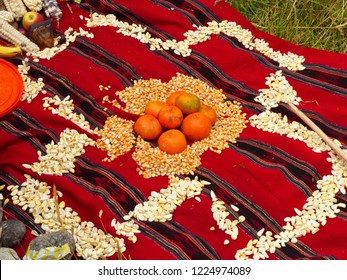Chakana is the popular element of the life and traditional designs in the life of many Andean cultures.

Chakana also served as the calendar and guide to important agricultural events ie sowing, etc.
Where possibly does the inspiration for this form come from?
We think that Chakana is derived from the base of the Lingam, which is represented in the form of Sriyantra. We associate this form made of 43 triangles with the Hindu tradition, but it has been used in the Indus Valley culture, and appeared even earlier, probably as early as in the Sumerian iconography.
The first document referring to the form of Chakana is the freehand drawn image in the manuscript of Pachacuti Yamqui dated in 1613. This form resembling the cross represents the idea of the genesis of the world Andean (executed on sheet of gold in the Coricancha temple in Cusco). This document has many interpretations which have been deduced from it (Pachacuti Yamqui [1613], 1993: 208; Milla Villena, 1983)
Representación de la idea de génesis de Joan de Santa Cruz Pachacuti Yamqui (1613). Fuente: Milla Villena (1983 [1613]: 232); y Milla Euribe (1990: 10)
The constellation Chakana or “Southern Cross” is understood as an orienting compass seen in the sky of the southern hemisphere of the globe, the Pacha in quechua. This constellation is always pointing towards the south pole and, therefore, providing - night to night - orientation throughout the year.
The speculative idea that the amautas (quechua - wise men), priests-astronomers and pre-Columbian architects “were lowering” the stars from the sky reflecting them in water mirrors, was not necessary to understand the form. Focusing on two lines, of different lengths, which only together make up the cross. On this basis, they built a square whose sides correspond to the short line and the diagonal to the long line— and then a polyvalent matrix that they in turn called Chakana.32 Thus, the Chakana was transformed —in its expression as a polyvalent matrix— into the guiding axis of high Andean culture (Fig. 1 and 6) .33 In this way, it is: “[…] represents this mystery of the universal chakana which builds between the living and the inert, between the feminine and the masculine, between the past and the future ”(Estermann, 2008: 228).
Lets take a look at the recently renovated chullpas from Bolivia, they show two rhombus with series of triangles at the perimeter - and we will compare this with the synthesized design of the Sri yantra on the right.



No comments:
Post a Comment